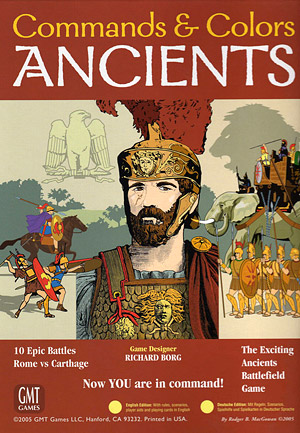We played, first, the battle of The Crimissos River (341 BC) between Hasdrubal of Carthage (me) and Timoleon of Syracuse (Chris). Here is the intro from the scenario:
The Carthaginians learned from earlier defeats in Sicily that they had to field reliable, trained heavy infantry of their own. They formed the Sacred Band, a force of about 2,500 excellently trained Carthaginians, as good or better than the best the Greeks or Syracusans could field. They formed a part of a large army under Hasdrubal, advancing eastward to subjugate Sicily. Opposing him with a much smaller army was the able tactician Timoleon. Ever aggressive, Timoleon anxiously awaited an opportunity to strike the Carthaginians a hard blow on his terms. He got that chance when, on a foggy morning, Hasdrubal carelessly ordered his army to cross the Crimissos River without bothering to send out scouts (who would have reported that Timoleon’s army was arrayed on the bluffs just beyond the river). Waiting until about half of the Carthaginian army had crossed, Timoleon unleashed his excellent heavy infantry phalanx against the surprised Carthaginians. Most who survived fled, but the Sacred Band stood their ground and were annihilated by superior numbers, (aided by a sudden rainstorm that slowed Carthaginian reinforcements crossing the river). Seeing the disaster unfolding across the river, the remainder of Hasdrubal’s army broke and fled. The loss of so many citizen soldiers had a horrific effect on Carthage. The Sacred Band was reformed, but only once was it ever dispatched from Africa again, and then only for a very short campaign.
Chris totally dominated my Carthaginians in this scenario, and he ended up winning 5-1 - a smashing defeat! The Carthaginian Sacred Band was his first target (they were playing "Houses of the Holy" and he doesn't like Zeppelin). His Syracusan Heavy Infantry totally outclassed my African Citizens.
We went on to play a second game, after some tasty treats from the Flying Dog brewery (I had the Doggy Style Classic Pale Ale, which is pretty low carb for my diet, and also the Snake Dog India Pale Ale - also low carb).
The second outing for us was the battle of Bagradas (253 BC). I got to play General Regulus and his Roman army, fighting in North Africa in this battle from the end of the First Punic War. Chris played the army of Xanthippus, a mercenary Greek general for the Carthaginians. Here is the text on the scenario from GMT:
The Romans are on the verge of defeating Carthage and ending the First Punic War. Regulus and a veteran Roman army have landed in Africa, and though woefully short of cavalry, have defeated several Carthaginian forces. Desperate, the Carthaginians turned to an otherwise unemployed Greek general, Xanthippus. While not on a par with Alexander the Great, Xanthippus at least knew how to train and command an army, and that was enough. The Carthaginian army marched into the Bagradas Valley, and Regulus, confident of yet another victory, offered battle. It was to prove a costly mistake for him. The Carthaginian cavalry and elephants routed the Roman cavalry, and then turned on the flanks and rear of the Roman army, now fully engaged with the Carthaginian infantry. The Roman army disintegrated. Those who survived told of the horror of being overrun by elephants and cavalry. This Carthaginian victory prolonged the war. It took several years before any Roman army would stand and fight against elephants. The larger lesson— proper employment of a combined arms army over a largely infantry army resulting in victory—was lost on the Romans. They had to re-learn it at the Trebbia, Lake Trasimenus and Cannae.
This one was much closer in the end. At the beginning, however, Chris was totally dominating my Roman army. The score after the first few exchanges was something like 5-1 in favor of the African force under Xanthippus, but then my Romans rallied, and it became 6-6. Finally, I got lucky, and it ended up at 7-7.
The Carthaginian Elephants were quite fun to play in this scenario, and when they rampaged (which they did several times) they were a danger to both sides.
I could have lost 6 battles in a row, and I still would have loved my time playing. A great evening.
Pet Peeve: people who walk up and see the game and say "oh, what a silly game, it looks like Stratego". Don't these people know this game came from Miniatures play, and was only later converted to a board game? Whatever.
Tags: wargames







